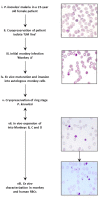Invasion characteristics of a Plasmodium knowlesi line newly isolated from a human
- PMID: 27097521
- PMCID: PMC4838912
- DOI: 10.1038/srep24623
Invasion characteristics of a Plasmodium knowlesi line newly isolated from a human
Abstract
Plasmodium knowlesi is extensively used as an important malaria model and is now recognized as an important cause of human malaria in Malaysia. The strains of P. knowlesi currently used for research were isolated many decades ago, raising concerns that they might no longer be representative of contemporary parasite populations. We derived a new P. knowlesi line (University Malaya line, UM01), from a patient admitted in Kuala Lumpur, Malaysia, and compared it with a human-adapted laboratory line (A1-H.1) derived from the P. knowlesi H strain. The UM01 and A1-H.1 lines readily invade human and macaque (Macaca fascicularis) normocytes with a preference for reticulocytes. Whereas invasion of human red blood cells was dependent on the presence of the Duffy antigen/receptor for chemokines (DARC) for both parasite lines, this was not the case for macaque red blood cells. Nonetheless, differences in invasion efficiency, gametocyte production and the length of the asexual cycle were noted between the two lines. It would be judicious to isolate and characterise numerous P. knowlesi lines for use in future experimental investigations of this zoonotic species.
Figures




References
-
- Sinton J. A. & Mulligan H. W. A critical review of the literature relating to the identification of the malarial parasites recorded from monkeys of the families Cercopithecidæ and Colobidæ. Rec Malaria Surv India 3, 357–380 (1932).
-
- Garnham P. C. C. In Malaria parasites and other haemosporidia Ch. 13, 323–356 (Blackwell Scientific Publications, 1966).
-
- Collins W. E. In Malaria. Principles and practice of malariology Vol. II (eds Wernsdorfer Walther H & McGregor Ian A) Ch. 48, 1473–1501 (Churchill Livingstone, 1988).
-
- Ciuca M. In Acta Conventus Tertii de Tropicis Atque Malariae Morbis Vol. Pars II. Acta Conventus Tertii de Malariae Morbis 327–345 (Spin C. A. & Zoon N. V.Amsterdam, Amsterdam, 1938).
Publication types
MeSH terms
Grants and funding
LinkOut - more resources
Full Text Sources
Other Literature Sources
Medical

